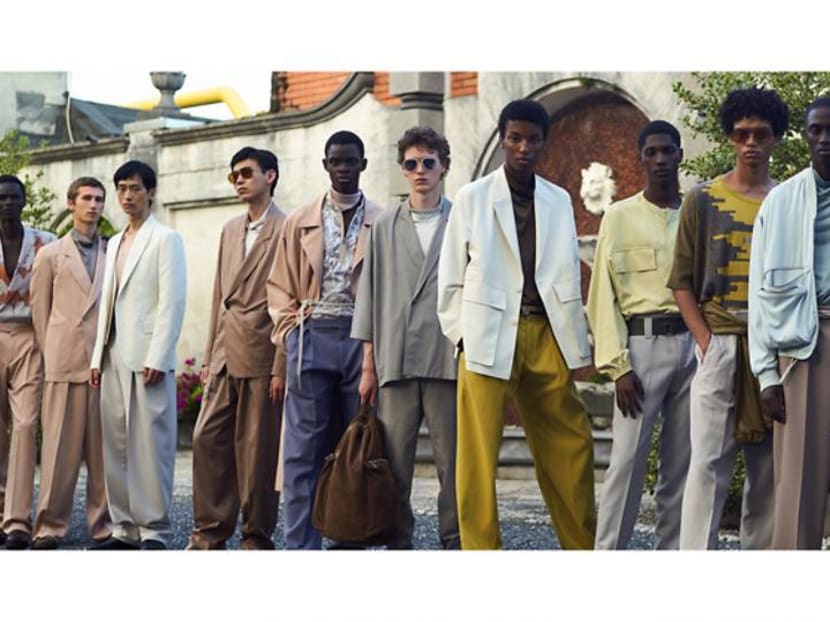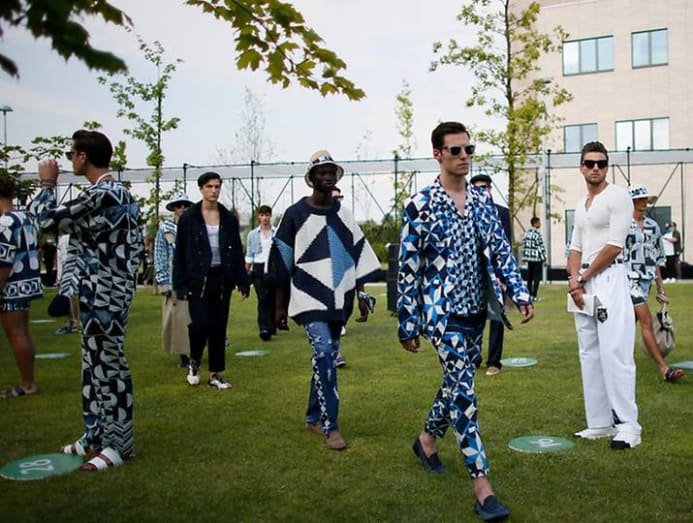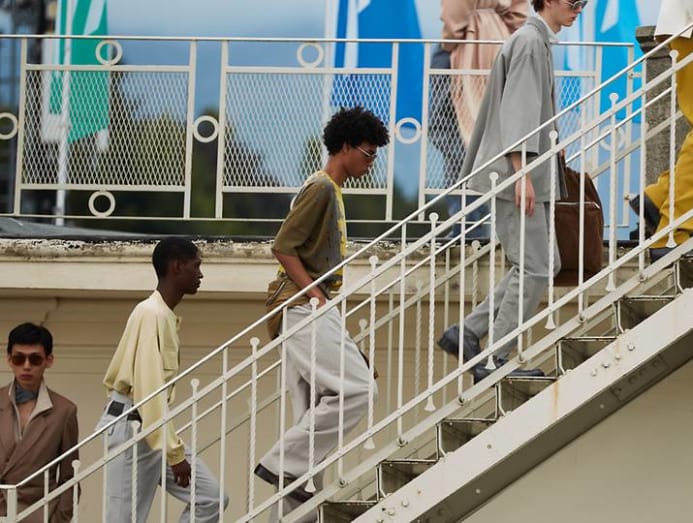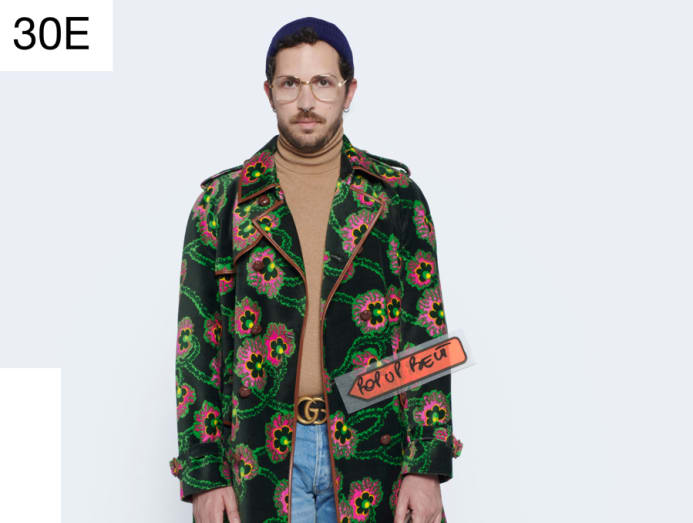Why are fashion brands still staging physical shows, despite the risk of COVID-19?
Advertizement
Obsessions
Why are fashion brands all the same staging physical shows, despite the adventure of COVID-19?
It was supposed to be Milan Digital Fashion Week, but designers like Dolce & Gabbana and Etro couldn't await to go back on the catwalk. There was something disconcerting about seeing this attempt to keep calm and catwalk on.

Ermenegildo Zegna'southward presentation consisted of soft, gently coloured tailoring, mostly worn over collarless shirts or silky T-shirts, more oft than non with trousers and jacket mismatched. (Photo: Zegna)
Milan'southward beginning allegedly "digital" fashion week concluded last Friday. I say allegedly, because despite hurrah-ing the online future of the catwalk, Etro and Dolce & Gabbana both hosted physical shows, attended by a smattering of printing, influencers and local celebrities.
Then, for some of those same attendees, it was a drive of several hours to a region n-west of Paris to watch a bucolic out-of-season prove past the immature French designer Simon Porte Jacquemus, staged in a field of wheat – a loaded symbol of prosperity and renewal.
With way heading back to not-and then-basic shows of several hundred people watching several dozen models, it all felt like business as usual.
Except, of class, it isn't. Economies are tanking, luxury takings are down and fashion brands are closing stores and cut staff, and equally of Fri confront coverings while shopping in the UK volition be mandatory. Which is why there was something not but incongruous merely downright disconcerting about seeing designers attempting to go on calm and catwalk on.
While the fashion business should continue – as a Us$2.5 trillion (S$3.46 trillion) global manufacture employing some 890,000 people in the Great britain alone, it must – it feels wrong for shows to carry on as if nothing were happening. Many hastened to add that social distancing was in place for the audience, but looking at the waving ears of wheat backdropping Jacquemus's wandering figures, I kept thinking of the cramped spaces traditionally allotted to models, hair and make-upwards artists and dressers labouring to assemble looks. Not to mention the cars ferrying those people, and the audience, dorsum and forth.
The show Etro staged in Milan was fifty-fifty more disconcerting: It was in the interior courtyard of the Four Seasons Hotel, a infinite I know and one that, though lovely (and open-air), is undeniably contained. It felt, if not unsafe, then unnecessary.
Domenico Dolce and Stefano Gabbana took inspiration for their menswear show from the Parco dei Principi hotel in Sorrento, designed in 1960 by Gio Ponti, and there was a kind of mid-century, mid-tempo, "Jackie Kennedy having an affair with an Italian poorboy" vibe to their by and large Mediterranean blue, predominantly printed and highly saleable offerings.
As opposed to Etro or Jacquemus, this bear witness, at to the lowest degree, had a stated signal other than hawking clobber: Since February, Dolce and Gabbana have been financing a written report at Milan's Humanitas University on COVID-19. This fourth dimension, they stated they would donate a role of the income from e-commerce sales of a handbag, and double donations made via a crowdfunding platform. The workers on the show besides donated their time for free, and the university was the venue.

That, at least, has an element of altruism. Merely, given the prospect of second spikes and the continuing need for citizens to maintain distance and sport masks, clustering people together – even outdoors – to spotter a agglomeration of unmasked models swaggering about feels foolhardy. It merely doesn't experience like the moment for these images.
Just besides all that, it feels reductive for designers to immediately stumble dorsum into the same old means of showing mode – especially when none of us knows what the futurity will bring. And, indeed, when we do know that we tin't all socially distance outside at shows in Europe in January without succumbing to frostbite. Shouldn't that requite an impetus to designer brands to investigate and invest in new and sustainable means of communicating their message?
Miuccia Prada did just that. She surrendered her dress – comprising her final collections before those created in partnership with Raf Simons, which will be unveiled, in some way, in Milan in September – to other creatives. A quintet of artists and photographers – Willy Vanderperre, Juergen Teller, Joana Piotrowska, Martine Syms and Terence Nance – created private films, entirely divorced from 1 another in mode.
It actually reminded me of those good former-fashioned way shows, where afterwards you talk to the person who was seated alongside and curiosity at their entirely different betoken of view. Although here, with each creative person showcasing different cinematography, music, models and ultimately intention – it was similar v fashion shows in one.
The clothes, yet, remained constant, and were great – a reminder of 1990s Prada: Skinny silhouettes in tech fabrics, unadorned and streamlined, minimally coloured, "an antitoxin to useless complication", Prada said – not complication as a whole, only the pointless stuff. It felt as if she was really drilling down into the essence of what Prada means, both for her and for the history books.
And she's about to rip it apart with an outside pair of eyes. So, regardless of pandemics, lockdowns and alternative ways of showing, this was a fascinating moment to examine Prada.
The collection was also commercially savvy. It was a bunch of great tailoring, slick black coats, party dresses that managed to avoid being brainless or off-brand, and a single, simple handbag. The message was direct and pure, which – in times of "useless complication" – is exactly what you want.
There was also something simple and pure to what Alessandro Sartori did at Ermenegildo Zegna: It was the best collection he has shown for the brand, integrating his interest in twisting and evolving tailoring with the frequently diametrical contrary aim of dressing real men. There was something modern to his ideas of soft, gently coloured tailoring, mostly worn over collarless shirts or silky T-shirts, more often than not with trousers and jacket mismatched.

Sartori's accompanying film for Zegna was swell: It showed men (they were models, but didn't await like it) striding through the Italian countryside, kicking upwards dust, on their way to Zegna'south manufacturing base in Trivero, Piedmont. It had an appealing directness – making y'all want to buy the dress and go running upwards that Piemontese hill. The Italian tourism office should be paying Sartori a royalty.
He dubbed the show "phygital", a fairly obvious portmanteau word, because role of the footage was pre-filmed and some recorded alive. In a preview, I asked Sartori if an audience would exist nowadays for the live portion, and he fair-skinned. In that location were 30 models and a whittled-downward coiffure of twoscore – the maximum the space would permit. He had worked within those limits to create something special for the moment.
Alessandro Michele'southward Gucci presentation had a similar experience. His wearing apparel were shot equally a lookbook, worn by his design team – and if people sometimes sneer at the designers proposing strange and archaic costumes as fashion when they themselves sport black sweaters and trainers, the Gucci crew were the perfect riposte. Of course, they were dolled up for a means to an end, but information technology did feel natural.

Michele showed his collection non in a 15-minute video simply over a 12-60 minutes livestream on Friday, during which the advertising campaign was shot. About halfway through, the photographs of the collection – of checked and geometric printed coats, of florid 70s-manner floral dresses and shirts, and plenty of Gucci-logo canvas on hats, bags and shoes – flashed up on screen in retro-seeming Windows 95-ish frames "like a Peeping Tom", said Michele.
Information technology sounds similar one of Miuccia Prada's useless complications but it really felt easy, engaging and relevant. I wound up watching the livestream of people flitting effectually the garden of a thou Roman palazzo for an hour or so – and in these strange times, beingness able to hold someone's attention for whatever menstruation feels similar a major achievement.
Past Alexander Fury © 2022 The Fiscal Times
READ> Was digital couture calendar week worth the fuss, straining already-tight manner budgets?
Recent Searches
Trending Topics
Source: https://cnalifestyle.channelnewsasia.com/obsessions/milan-digital-fashion-week-247756

0 Response to "Why are fashion brands still staging physical shows, despite the risk of COVID-19?"
Post a Comment